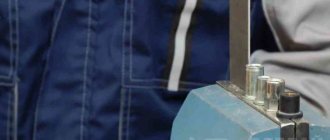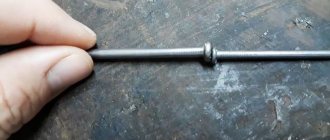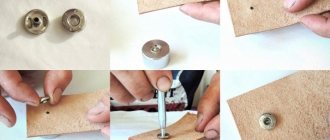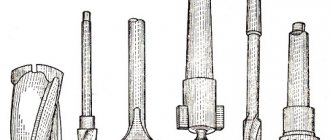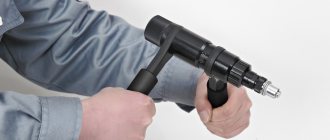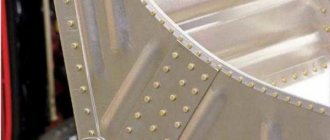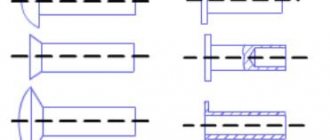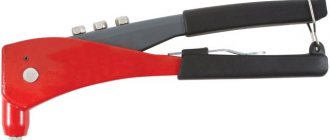Author of the article:
Threaded rivets are a common type of fastening elements that are used in construction, repair shops, mechanical engineering, and other industries. They, like ordinary blind rivets, are used to connect metal parts. In addition, they have an internal thread, which allows them to create space for a bolted connection. This makes it possible to fasten parts or structural elements to the surface of sheet metal using bolts or screws. Installation of threaded rivets is recommended in cases where parts need to be bolted to the surface of a thin metal sheet and there is no access to the installation site from the reverse side. Due to the small thickness of the sheet, it is impossible to cut an internal thread in the hole, and the lack of access from the back side does not allow screwing on the nut. If parts are not required to be secured with bolts or screws, the use of such fasteners is not practical. In this case, conventional blind or driven rivets are used.
To quickly and efficiently perform installation, you need to know how to rivet a threaded rivet, including without special tools.
Principle of operation
The principle of operation of threaded rivets is that after installing such a locking element, a thread is created. A screw or bolt is then screwed into it.
Installation of threaded rivets is carried out very quickly and efficiently, but only when using a special tool. Such devices can be purchased at different prices.
If there is a need to use this type of fastener, then each master can easily choose the most suitable type of riveter for himself.
The video shows the working principle of a threaded rivet:
The tool is ideal for installing rivets in hard-to-reach places, because the product weighs only 900 g. The Gesipa Firefly comes with a set of attachments that can be used to work with rivets of sizes from M3 to M6.
2. AirPro HN-911. Despite the high cost, this rivet model has a number of advantages, which is why it is most often preferred by professionals working with metals.
Among the advantages of the AirPro HN-911 are ergonomic handles, stroke adjustment, and a lightweight cast aluminum body.
Also, using this riveter model, you can install large diameter fasteners. Thanks to the attachments included in the tool kit, you can work with rivets of sizes M4 – M10.
3. Bralo TR-212. Powerful tool for installing threaded rivets.
The length of the riveter is 530 mm, so when force is applied to the handles, sufficient force is created to install large consumables. The range of sizes used when carrying out work using Bralo TR-212 is from M8 to M12.
The manual riveter of this model is equipped with anti-slip handles, which allows you to work comfortably even when installing large threaded rods.
The tool is also well suited for work where it is necessary to frequently change the diameter of the consumables used. The design of Bralo TR-212 has a convenient mechanism with which you can quickly change the equipment used.
Models with battery
The productivity of installation of threaded rivets can be significantly increased by using special power tools. Considering the fact that the technician has to travel a considerable distance when installing this type of mount, models equipped with a rechargeable battery have become popular.
Among portable electric riveters, the following models are the most popular among buyers.
1. Gesipa Firebirg. This model of battery riveter is manufactured in Germany, so the quality of the product is at the highest level. Despite the total weight of 2 kg, the device allows you to operate with one hand.
The main qualities of this model also include good balancing and a comfortable handle, so you can easily hold the tool when working in hard-to-reach places.
Durability of use of Gesipa Firebirg is achieved due to the presence of electronic control and protection systems against overheating and excessive loads.
The tool of this model allows you to work with rivets made of various metals, the diameter of which ranges from 2.4 to 6.3 mm.
2. Scell-it E-480NB. This model of cordless riveter allows you to perform a large amount of work both indoors and outdoors. The absence of the need to connect to a 220 volt network makes the installation of threaded rivets as quick as possible.
The tool weighs less than one and a half kilograms, so you can work with one hand when performing complex operations. Among the useful options of the Scell-it E-480NB is an LED backlight, with which you can illuminate the holes to ensure more accurate installation of the fastener.
The device allows you to work with rivets made of steel or aluminum. When using aluminum parts, the maximum diameter of the rivets can be 8 mm, when working with steel – 6 mm.
3. Absolut SK 6000. This riveter model is ideal for work where mobility is required.
There is no need to connect to an electrical network or to a compressed gas cylinder, making it easy to carry out roofing work or install rivets when installing ventilation systems.
The charging time of the 1.4 Ah battery is only 30 minutes, so even when performing a large volume of work, delays will be minimal. With the Absolut SK 6000 you can install steel rivets with a diameter of 4 - 6 mm, as well as aluminum products with a diameter of 4 - 8 mm.
The main disadvantage of battery-powered riveters is the need to periodically take a break to recharge the battery. If you need to do a large amount of work, you will need to purchase 2 tools that will be used alternately.
Riveters operating on compressed air are completely free of this drawback, so if the product is necessary for professional activities, then it is better to buy a pneumatic riveter.
Pneumatic riveters
1. Airpro SA8907. Pneumo-hydraulic riveter made in Taiwan. It has high traction force and excellent ergonomic qualities.
The weight of the product is only 1.55 kg, so even if you need to work with one hand, this model will allow you to perform riveting operations with minimal effort.
The tool allows you to work with steel and aluminum rivets. The diameter of which does not exceed 10 mm.
2. VVG VNG 703. German riveter, which has increased productivity and excellent performance.
The tool has a high pulling force, but thanks to the ability to adjust this parameter, it is possible to install even small aluminum rivets without deformation.
Using VVG VNG 703, consumables are installed, both from ordinary steel and stainless steel. The maximum diameter of the rivet, regardless of the metal used, is 8 mm.
All of the tools presented above differ significantly in price, so you should carefully calculate the amount you will need to purchase a riveter.
- If the product is necessary for professional activities, then buying a cheap model will lead to the need to go to the store again, after a short period of time.
- Purchasing an expensive device for rare home use, on the contrary, will be a waste of money.
- You can also make a riveter for threaded rivets with your own hands, but such a product is unlikely to be able to ensure high-quality work.
Metal riveting
The process of riveting metals consists of two stages: preparatory and the actual installation of hardware. Preparation - drilling holes, if necessary, countersinking for countersunk heads
Please note that countersunk heads can be on one (either) side or on both
The riveting process itself is as follows:
- insert the rivet;
- tighten the parts to be connected;
- form a closing head using a tool;
- check and clean the connection.
This is how blind rivets are installed
With a good tool, work goes quickly. For private use and one-time work, manual riveters are usually used. And even with them, the process itself (without drilling holes) takes a matter of seconds. If we talk about installing corrugated sheets or metal tiles, it is recommended to coat each hole made with paint to prevent corrosion. It is these processes - drilling and painting - that take a lot of time.
In general, there are two ways to install rivets: cold and hot. When hot, the joint is preheated to a certain temperature (determined by the metal and the thickness of the parts). In practice, it is used when installing rivets of large diameter - 12 mm or more.
The rivets are placed in rows. The minimum distance between adjacent ones is 4 diameters; from the edge of the sheet to the center of the hardware is no less than 1.5 times the diameter of the rivet. When attaching a profiled sheet, place it in a recess, not in a wave.
This is interesting: Classification and types of corrugated sheeting for construction - what you need to know
Installing the Fastener
Installing a threaded rivet is practically no different from using conventional rivets. All work is carried out in several stages:
- A hole of the required diameter is drilled in the workpiece.
- The threaded rod of the rivet gun is screwed into the rivet and the rivet is inserted into the hole.
- The threaded rod is pulled into the body of the rivet gun and the part of the rivet that does not have an internal thread is compressed, securely fixing the rivet in the hole.
If a large number of installation operations are to be performed, then to increase productivity, it is recommended to first make the required number of holes. And then start installing fasteners.
Source: plavitmetall.ru
Summary
As you can see, each type of rivet plays its role and is necessary. If conventional ones can be replaced with exhaust ones, then threaded ones are unique in their class and make it possible to install additional equipment where it is difficult to use any other method of fixation. The diameter of the clamp is selected depending on the needs. Factory riveters for threaded elements are most often supplied in a plastic case for greater ease of storage. If there is a need to install components of large diameters, then a model with two handles is better suited.
The old-fashioned way of installing a threaded rivet without a rivet gun?
Continuing the topic of threaded rivets, I would like to tell you one interesting way that will help you avoid buying an expensive rivet gun.
However, it’s worth mentioning right away that the process is somewhat labor-intensive. Therefore, if you have a lot of rivets that need to be riveted, then it is still better to use the “services” of a riveter.
For those who literally have two or three threaded rivets waiting in the wings, then this method is for you.
- The rivet
itself . - Drill
or cordless
screwdriver
. - Bolt
or
screw
. - One connecting nut
or 3 simple ones. - Enlarged washer.
You need to drill a hole and put a rivet there - this is the default. So, the installation itself takes place literally in several stages:
1. Let's wind it up
one connecting nut or three regular nuts per bolt/screw.
2. We put
there is an enlarged washer.
3. Screw it in
in a rivet.
4. Use a screwdriver or drill to tighten
bolt/screw, thereby pulling out the hidden part of the rivet.
5. Unscrew
screw/bolt
If you don’t have a drill or screwdriver, you can use a regular wrench (only in this case you will have to use a bolt, not a screw).
That's all. Everything is very simple, wouldn’t you agree?
Good luck with your experiments! And also subscribe to the channel and like. There is still a lot of interesting things ahead, including experiments.
Source: zen.yandex.ru
Step-by-step instruction
If there is a rivet gun, it needs to be adjusted to the corresponding rivet nut, and the stroke of the threaded rod must be adjusted in accordance with the length of the rivet. If all adjustments are correct, the step-by-step instructions for installing a threaded rivet look, in general terms, as follows:
- connect parts or structural elements as required;
- knowing the diameter of the rivet, choose a drill 0.1 mm larger in diameter;
- drill the workpieces, trying to maintain perpendicularity;
- screw the rivet onto the rod of the riveter nozzle;
- install the connection by pulling out the threaded rod using the handles of the riveter;
- unscrew the rivet.
That's all, fastening with a screw rivet is done. If necessary, you can strengthen the connection using a bolt and nut or install any other structural element using a bolt, since a threaded fastener has appeared on the surface.
It is quite possible to secure a threaded rivet without a riveter using a homemade device.
If the device is assembled from the elements given above, in general terms, installing a rivet with it is as follows:
- drill a mounting hole with a diameter 0.1 mm larger than the diameter of the rivet;
- assemble a homemade riveter: screw a nut onto a long bolt with a thread corresponding to the thread of the consumable, put a washer on it, then install a sleeve, which is also covered with a washer;
- screw a rivet onto the end of the bolt;
- turning the nut, ensure that the sleeve through the washer rests against the head of the rivet;
- insert the rivet into the prepared hole;
- holding the bolt from turning with a wrench, use another wrench to turn the nut so as to pull out the bolt and deform the rivet;
- When it becomes difficult to turn, unscrew the bolt.
If necessary, you can strengthen the connection with a bolt and nut.
It is clear that homemade designs for installing threaded rivets, made by different craftsmen under different conditions from different components, may differ slightly.
An additional design element for a homemade device for riveting with threaded consumables can be a small bearing, which allows you to concentrate the force on the operation itself, reducing unnecessary friction.
santey311 › Blog › Device for installing threaded rivets
We all know what a great thing threaded rivets are.
In some cases there is no alternative to them. Until one certain time, I somehow managed without them. But one fine day a wonderful car came to me and needed window protection installed. Like this:
Then I started working on collective farms, and in the end I ended up with a device that was not very presentable in appearance, but very functional, and with its help I have installed more than a dozen rivets. The base is an M6 bolt, strength 8.8
This is what it looks like assembled, with the rivet installed
Main parts: M6 bolt. A piece of M12 bolt. More precisely, there was no bolt, no stud. A nut is welded on one side, turning it into a bolt. The stud is drilled through D=6.5mm. Then comes the nut from the UAZ stepladder. Strong. Next is the support bearing, the dimensions are not important. Next is a washer with a fitting from the brake pipe. It doesn't matter either. I installed what was there.
I think the principle of operation is clear. We drill a hole, under the M6 rivet it seems 9mm. We insert the device. Use one wrench to hold nut 1, and use the second wrench to unscrew nut 2.
As the effort increases, the riveting is completed. We twist everything back until it loosens, unscrew the M6 bolt, and install the next one.
Source: www.drive2.ru
Metal riveting
The process of riveting metals consists of two stages: preparatory and the actual installation of hardware. Preparation - drilling holes, if necessary, countersinking for countersunk heads
Please note that countersunk heads can be on one (either) side or on both
The riveting process itself is as follows:
- insert the rivet;
- tighten the parts to be connected;
- form a closing head using a tool;
check and clean the connection.
This is how blind rivets are installed
With a good tool, work goes quickly. For private use and one-time work, manual riveters are usually used. And even with them, the process itself (without drilling holes) takes a matter of seconds. If we talk about installing corrugated sheets or metal tiles, it is recommended to coat each hole made with paint to prevent corrosion. It is these processes - drilling and painting - that take a lot of time.
In general, there are two ways to install rivets: cold and hot. When hot, the joint is preheated to a certain temperature (determined by the metal and the thickness of the parts). In practice, it is used when installing rivets of large diameter - 12 mm or more.
The rivets are placed in rows. The minimum distance between adjacent ones is 4 diameters; from the edge of the sheet to the center of the hardware is no less than 1.5 times the diameter of the rivet. When attaching a profiled sheet, place it in a recess, not in a wave.
How to install a threaded rivet
When mounting various parts to sheet steel elements, threaded rivets are an excellent fixation option. A distinctive feature of such rivets is that in addition to the ability to fasten two sheets together, they allow you to screw a screw or nut into the resulting rivet joint.
The website krepcom.ru offers a wide range of rivets with internal threads. You can select rivets of different sections (round, hexagonal, knurled), different lengths and different diameters. However, the question arises: how to attach such rivets? The rivet manufacturer recommends a special tool for use. The essence of how such a tool works is that the rivet is screwed onto a special tip, the resulting structure is inserted into the holes of the metal being fastened, after which the rivet is “pulled” into the side of the tool. As a result of tightening, a shoulder is formed, which allows the rivet to hold securely on the sheets being fastened. To release the rivet from the tool, it is screwed together.
The described method is very good. High performance guaranteed. Only the cost of a specialized tool cannot be called acceptable for household use. But the need for installed threaded rivets may also arise in everyday life. There is a technique that allows you to install a threaded rivet without using special tools.
All you need is a screwdriver and a few hardware. Instead of three nuts, as shown in the photo, you can use one extended nut. The process boils down to the fact that a rivet with a structure screwed onto it is inserted into the drilled hole, the screwdriver is turned to the “twisting” mode, the rivet is tightly fixed with the appearance of a “shoulder”. If the force generated by the screwdriver is insufficient, you can tighten it manually with a hex wrench, because A hex head screw is used. After completing the tightening process, the screwdriver is set to the “unscrewing” mode and the screw is unscrewed from the rivet.
If you need to install a small number of rivets, you can take a bolt instead of a screw and turn it with wrenches. The speed of the process will be less than with a screwdriver, but this is not critical due to the small number of attachment points.
The use of a special riveter will make it possible not to use the proposed design, and productivity will be higher. However, a riveter costs about $70 and the proposed method is an excellent option for saving your budget.
Source: krepcom.ru
The most reliable connection of parts
Sometimes, due to design features, it is impossible to move the connection point. In this case, a special attachment, which is fixed on the side of the head, can help. When choosing the size and weight of the attachment, you need to take into account the thickness of the connection, as well as the material of the rivets. After this, you can begin riveting the free side.
It is optimal for the connecting metal to fill the entire space of the hole, and caps appear from each side, which should fix the parts. This method can be used not only to connect parts to each other, but also to seal holes in one sheet. This method is often used by craftsmen when they need to repair leaky containers.
When manufacturing metal structures, it is not always possible to connect parts by welding. In such cases, you have to resort to a more careful method of fixing the elements, which involves the use of rivets. With its help, you can securely fix the connected elements together. However, you need to remember that ensuring the quality of the connection is not as easy as it might seem at first glance. It depends not only on the riveter, which today manufacturers produce in various versions.
The rivet fastener itself also plays an important role in the process of fixing elements. How long the fastened parts will remain in this position depends on its correct choice.
Beginning craftsmen are required not only to choose the right rivets, but also to learn how parts should be connected using this fastener
Here it is very important to correctly select the required force for fixing the elements being connected, otherwise, when the product is loaded, these parts may become loose, as a result of which everything will have to be redone
Threaded rivets
In the past, the most common fastening elements were rivets (especially in the mid-20th century). To date, they have been significantly supplanted, but still remain relevant in some cases. Next, we consider one of the types of fastening elements - threaded rivets: their general features, classification, areas and technology of application.
Dimensions
The selection of the optimal dimensions of a threaded rivet depends on several important factors. These include the type of hardware product, as well as the total thickness of the fastened elements of a particular structure. With the same thread parameters, the length will be determined by the type of fastener.
It is important to consider that most models are available in two versions - normal (standard) and extended. For example, a typical stainless steel rivet may have the following dimensions:
- Thread – from M4 to M10.
- Length – from 11 to 24 mm.
- The diameter of the rivet and hole is from 6 to 13 mm.
- The diameter of the collar is from 9 to 17 mm.
At the stage of selecting rivets, it is strongly recommended to use the corresponding tables, which indicate all their key parameters. Now you can easily find all the necessary information on specialized resources.
Peculiarities
Rivets are fasteners in the form of a sleeve or rod with a rivet head at one end and a head that closes during the rivet process at the other. Threaded rivets differ from blind rivets by the presence of threads. That is, they are hexagonal or cylindrical bushings with a supporting flange at the top and threads at the bottom. The upper part is made in the form of a thin-walled tube without threads and often has a longitudinal external notch. During installation it becomes deformed. The vertical notch on the top ensures uniform deformation and prevents tearing of the material.
The advantages of threaded rivets include:
- ease of use;
- strong bonding of elements made of fragile and thin materials such as sheet metal without deformation;
- the possibility of one-sided fixation if the total thickness of the parts being connected exceeds the length of the fastening element without loss of strength;
- maintaining the strength of the connection over time;
- mechanical and chemical non-aggressiveness;
- maintaining the integrity of the surface and paintwork;
- the ability to connect elements from different materials;
- absence of mechanical stress in the structure;
- Possibility of dismantling and reinstallation.
Despite the fact that nowadays, in most cases, instead of rivets, welded or glued joints are used, the fasteners under consideration have a number of advantages in comparison with them, which determine their indispensability in some assemblies. First, threaded rivets can withstand heat. Secondly, they do not cause structural changes in elements during installation, unlike welding, which is especially important when connecting parts made of different materials, the behavior of which can be unpredictable. Third, threaded rivets ensure mobility is maintained.
However, these fasteners have a number of disadvantages:
- installation is complicated by the need to pre-make holes;
- most threaded rivets do not ensure tight seams;
- installation is associated with a high noise level.
Due to the variety of threaded rivets, their classification is very difficult.
So, according to the material they are differentiated into:
- carbon steel;
- stainless steel;
- aluminum;
- copper.
In addition, there are polymer models (neoprene). They do not require specialized tools to install, which is why they are called self-installing.
By type of thread there are:
- nuts - with threads on the inner surface, creating a permanent connection (threaded rivet nuts);
- screw - the thread is located on the outer surface, creating collapsible connections.
In addition, according to the shape of the head, threaded rivets are classified into flat and countersunk, according to the profile of the legs - into round and hexagonal, and according to the configuration of the sides - into open, countersunk, small, closed, large.
In addition, these fasteners are produced for various diameters and thread pitches of the hung elements. For internally threaded rivets the diameters are usually M4 – M8, for screw rivets – M3 – M16.
Finally, there are threaded rivets with additional specific parameters: electrically conductive, with an enlarged head, with vibration isolation, with increased force, with marks, sealed, with inch threads, etc.
Installation process
The algorithm for installing a threaded element can hardly be called overwhelming, but it is important to know certain nuances. If possible, it is better to use a factory riveter. If desired, you can assemble it yourself; one option will be discussed below.
The first step is to determine the type of metal on which the rivet will be installed. Next, you need to know what the diameter of the bolt or module that will be fixed thanks to this rivet is. According to the specified diameter, the appropriate rivet is selected. Its outer diameter is measured and a drill is selected that will be one tenth in diameter larger than the rivet. This is necessary so that the latter fits in its place without much effort or obstacles.
If desired, you can assemble it yourself; one option will be discussed below. The first step is to determine the type of metal on which the rivet will be installed. Next, you need to know what the diameter of the bolt or module that will be fixed thanks to this rivet is. According to the specified diameter, the appropriate rivet is selected. Its outer diameter is measured and a drill is selected that will be one tenth in diameter larger than the rivet. This is necessary so that the latter fits into place without much effort or obstacles.
Electric or cordless drill. The metal is drilled in the required location. After this, the fastening element is inserted into the seat. If it needs to be placed in a certain position, then it is better to hold it with your hands. For hexagonal holes, you can use special punches if we are talking about thin metal. If the thickness of the metal is greater than the length of the fastener, then the hole must be drilled a little deeper than the fastener, but there is no need to make a through penetration. After this, a rivet maker core is selected that fits the thread to the element being installed. The handles are brought together or the bolt is rotated so that part of the rivet is deformed and fixed in the hole.
You should not apply too much force, as you can tear off the thread, which will later be used to fix the required part. It is necessary to ensure that the rivet is installed in the required position. After this, you can fix the required product using a screw or bolt.
Usage
There are several steps required to install the rivets.
- First of all, using a tool, a hole is formed into which the rod will subsequently be inserted. The size of the hole is calculated taking into account that it should be 10–15 percent greater than the volume of the rod.
- The hardware must be immersed in the hole so that the head is visible on the back side of the structure. Installation of threaded elements can be done with a manual riveter. Expanding and explosive types of products are fixed using an electric or piston tool.
The main areas of use of rivets are mechanical engineering, shipbuilding, construction of buildings, ventilated facades, the formation of playgrounds, as well as decorative fasteners. This type of hardware is not used when fastening heavy objects. Experts recommend buying flexible yet durable products, such as carbon steel, aluminum or copper.
In the next video you will find yourself making rivets with your own hands from colored materials.
Varieties
The difference between rivets of this type lies not only in their diameter, but also in other parameters, one of which is the metal of manufacture. The following can be used as a basis:
Each of these metals has its own advantages over others. Regular steel rivets are most often coated with zinc to prevent rust during use. In this regard, stainless steel products benefit, but their cost is slightly higher. They also have greater strength. Copper and aluminum are used in cases where interaction with a similar metal is required, and the rivet will not hold a module that is too heavy. Each element has a head that guarantees fixation on the front side. It can be flat or hidden. The second option will require widening the outer diameter of the hole to hide the sides. Blind rivets are used most often in case of one-sided installation. The latter is carried out in a situation where the thickness of the metal of the workpiece is greater than the rivet and the latter does not have the opportunity to fully compress it. In this embodiment, fixation occurs due to the expansion of the element body inside the hole.
Read also: Temperature regulator on lm358 circuit
Mounted modules have different pitches and thread diameters, so products are required to match them. That is why companies producing such fasteners are most often ready to provide their customers with rivets that have a diameter from M4 to M8. This applies to nut structures when there is no access to the reverse side of the metal. There is also a collapsible screw type, which is available in sizes from M3 to M16. The cut profile of the product may also be different. Most often, round is used, but hexagonal can also be used. In the second case, making a hole for such a unit requires some effort, but turning it is much more difficult, and in some cases impossible, when compared with the round version.
Threaded rivets can be specialized, so depending on the application, they may have reduced resistance to electrical current. Other elements have increased strength, because they are designed to work under heavy loads. Depending on the shape, the clamps are able to provide a tight connection. The heads of some elements have special marks that allow them to be identified among other products. Vibration-isolating rivets are often used in automobiles. Especially when it comes to mounting on body parts.
STRENGTH OF RIVET CONNECTION
The main strength parameters are mechanical shear and tensile strength. The values of these parameters are indicated in the catalog for each type of rivet separately. However, the main element and an indispensable condition for the high strength of the entire rivet joint is a correctly formed closing head of the rivet.
SHEAR STRENGTH
This is the maximum force that the rivet can have directed along its length. The tensile strength is determined by testing and has a minimum average value. Measured in Newtons (N)
TENSUAL STRENGTH
This is the maximum force that the rivet can have directed along its length. The tensile strength is determined by testing and has a minimum average value. Measured in Newtons (N)
Kinds
The type of hardware is selected in accordance with the connection requirements. Due to the fact that the modern fastener market offers a wide range of blind rivets, choosing the right element will not be difficult. Depending on their performance characteristics, hardware is divided into several types.
Combined models are considered the most common type. Hardware is capable of providing permanent connection of particularly hard parts subjected to mechanical, weight and vibration loads.
- Sealed models have a rather narrow specialization and are widely used in shipbuilding industries. A design feature of blind models is the soldered end of the rod. Products can be made of stainless steel, copper and aluminum.
- Multi-clamp models have several riveting sections and are installed in movable structures when it is necessary to connect three or more elements. Such a section is located between two adjacent elements, and installation is carried out using a pneumatic gun.
In addition to traditional models, there are reinforced versions of rivets, the manufacture of which uses stronger material with thicker walls.
Overview of species
Nut or screw rivets are available on the market in a wide range.
Each type of this product has its own characteristics and advantages, as well as scope of application. Therefore, first you need to understand the characteristics in order to make the right choice. Rivets are distinguished by their design, namely the internal thread, since it forms a closure belt during compression. These products are distinguished by the type of head and type of thread. The M4 - 8 nut rivet has a permanent connection, so it is only suitable for conditions where movement is limited, if it is impossible to access the back of the part. The screw sample belongs to the category of collapsible rivets. The profile of the leg also differs between products - hexagonal and round. The type of collar can be open, closed, hidden, small or large, which should also be taken into account when choosing a fastener.
The hexagonal rivet is intended for fastening sheet profiles to each other. This nut looks like a sleeve with an internal thread. This element is an excellent alternative to welded joints, so you can fasten products with thin-walled material. Often used in the manufacture of furniture, electrical devices, air conditioning systems and the manufacture of metal cabinets. A blind nut is designed to create threads when using screws, studs and bolts. If tight fastening is required, it is better to choose this option. Thanks to standard sides, deformation of the base material is prevented, since the contact area is large. To install such a rivet, you need to drill a hole.
Cage nuts are used when there is no fastening element. If there is a hole, but no thread, this product will help out. However, this will require a special tool that is designed to work with blind nuts. The most common form of riveting nuts is cylindrical. This is a strong item that is easy to work with.
